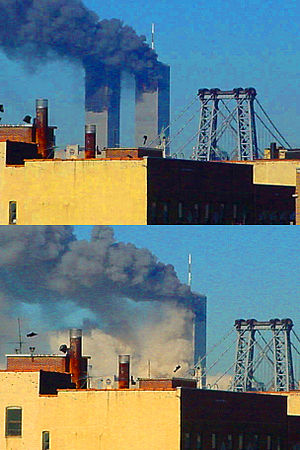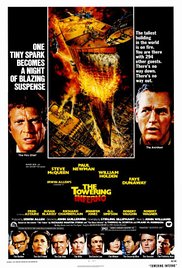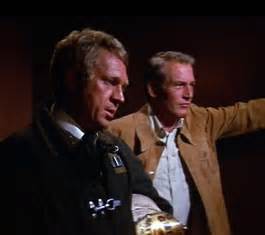
On Friday, I was given a lift to Barry Norman’s funeral in the Hertfordshire village where he lived for many years. We drove north from the Radio Times office in Hammersmith, West London, and although I wasn’t looking for it, I saw the corpse of Grenfell Tower for the first time. Forgive me for taking a picture of it, but it stopped me short; it was like glimpsing the Hollywood sign for the first time in Los Angeles, or Guernica in the Reina Sofia in Madrid (neither of which landmark did I attempt to photograph, incidentally – one occurred before the ubiquity of camera-phones, the other would have been inappropriate and they were selling postcards in the gift shop). My photo of Grenfell, as we all now know it, was taken quickly, on a bad, old phone, and in motion on a roundabout, but even in this non-prizewinning form, it still it chills my blood.
Unlike the other two famous towers that were destroyed, Grenfell still stands. And in this, is it powerful. It is a constant – if not, one assumes, permanent – reminder of what went on here, in my city, in a borough I often have cause to visit, one of the wealthiest boroughs in the world, not just in London. What actually went on here, the tragedy itself, happened in a relatively short space of time. The Twin Towers in New York were destroyed in approximately an hour and three quarters, between the first impact, and the second collapse (although thousands of tons of toxic dust, comprising asbestos and other contaminants, not to mention human tissue, lingered for days, weeks, months – in fact, 18,000 people are said to have been made ill by the dust and pre-9/11 air quality did not return until June 2002). Grenfell took around 60 hours to burn itself out, having started after a fridge freezer caught fire at around 1am. There is no point in pressing any further comparisons. The towers in New York were built in the 1970s predominantly for private enterprise and were designed not to collapse, or kill anybody. Grenfell Tower, and others like it, were built as social housing, and were run and maintained by the state.

Ironically perhaps, the Trade Center was not properly fireproofed, and in September 2001, replacement cladding was in the early stages of being replaced: only 18 floors of WTC1 had been improved before the planes hit and made that immaterial. (A fire in 1975 had affected six floors of one tower before being successfully put out.) The World Trade Center was clearly named. It was built to regenerate Lower Manhattan and around 40% of it would be leased to private, business tenants, with rent going to the Port Authority. (The rest would house government and federal offices.) Many who objected to the project felt it shouldn’t be “subsidised” (they hate that, messing with the market) and disputed the notion of a state body moving into private real estate at all. But the Port Authority, which basically controls everything that comes in and goes out of New York and New Jersey, runs on rents, fees and tolls for tunnels and bridges. It’s complicated, in other words.

Grenfell Tower, a mere 24 storeys high, was completed a year after its taller, more aggressive New York cousins, in 1974. (The ribbon was cut on the WTC in April 1973, which meant it was up and running in time to replace the Empire State Building in a brash, oil-embargo Hollywood remake of King Kong, with the giant ape misleadingly able to put one monkey foot on either Tower and straddle it in the publicity materials.) Grenfell, named after an adjoining road, itself named after a Field Marshall who fought in the Anglo-Zulu War, was built in the Brutalist style, which I happen to rather like, as a style. (I wouldn’t want to live anywhere above three floors though.) It was nicknamed “the Moroccan Tower” by locals to reflect the ethnic bias of those who lived in it in the mid-70s. In the mid-80s, Margaret Thatcher encouraged council tenants to buy their flats and then vote for her. Only 14 of Grenfell’s 120 flats were privately owned when it burned down.

When I ghoulishly but instinctively took a photo of the husk of Grenfell from my friend’s car on Friday I didn’t need to. The husk is on the news – certainly Channel 4 News, and London Tonight – every night. It is now almost five weeks since the fire, but just as the charcoal parody of a tower block refuses to stop sticking a middle finger into the London skyline on a round-the-clock basis, the story will not go away. Nor, inconveniently, will the surviving residents, who seem to have solidified through community spirit into a permanent working party action group on behalf of all people who live in towers in this country. Many Grenfell residents raised concerns about safety, not least fire safety, in the months before the fire, but were dismissed by Kensington and Chelsea Council as trouble makers. (This is the Tory-run council that took £55 million in rent in 2016 but invested less than £40 million in council housing.) It is not forced or wishful to view the horrific demise of at least 80 people – a figure kept lower than the assumed 100-plus by lack of DNA evidence – as a class issue. (Some found it intrusive but I didn’t when Victoria Darbyshire hugged a grieving, shellshocked eyewitness, resident and survivor live on the BBC. For me, it melted away barriers.)

By “class” I don’t mean middle-class, or upper-class, or working-class, I mean a much starker divide: the one between people who can afford to live in London and people who frankly can’t, but stick it out and hope for the best as they have no other option on account of family, friends, local links, workplace and other fanciful factors that affect actual human beings. Suspicion was aroused among aggrieved and grieving Grenfell refugees when retired Appeal Court judge Sir Martin Moore-Bick was appointed to lead a public inquiry that even he forewarned wouldn’t satisfy everybody. (In November 2014 he’d upheld a judgment that Westminster Council could offer housing to a woman who, with her children, had been evicted from privately rented local housing and offered alternative accommodation 50 miles away. Not a great omen.) The killing joke about Grenfell is that its “refurbishment” had only ever been external; a way of improving the view for other residents ie. private ones.

Theresa May, apparently still Britain’s Prime Minister, called Grenfell “a failure of the state,” as if perhaps “the state” was nothing to do with her, or her cabinet. It was a failure, but one that has killed over 100 people who had done nothing to deserve it except try to scrape a living in a part of London that neatly represents the poles of social experience within one arbitrary boundary. There are residential units owned in Kensington and Chelsea by billionaires in Singapore who will never step foot in them. They do not take advantage of local facilities, nor engage in local activities, for they do not live in their properties. They do not contribute to the local economy like the residents of Grenfell Tower, not even buying a packet of chewing gum from a local shop. This is the obscenity of capitalism. Not a failure of the state, but a failure of the private sector, with its tentacles into everything and its empathy for nothing. Capitalism is the bottom line. Grenfell Tower fell below that line: too full of people on the breadline, and from foreign countries, to care too much about with their petty complaints about exposed gas pipes, blocked fire exits and the “stay put” advice on each floor that might have had some credibility had the cladding used to smarten the building up from the outside not been made of petrol-soaked kindling, or something.

Some experts and one or two Hollywood scenarists had predicted a plane crashing, accidentally, into a skyscraper. But nobody saw two hijacked passenger jets being deliberately flown into towers by synchronised suicidal madmen with pinpoint piloting skills, just after breakfast on a balmy September morning. A whole lot more people predicted a fire in Grenfell Tower.
We can only hope that the inquiry and the inquest, and whatever has to come next to compensate for the lack of clear answers and blame after the inquiry and the inquest, don’t drag this out for as long as Hillsborough. The Grenfell Action Group don’t even yet have a figure to put on their tragedy; a number to hammer home to anyone seeing their banners, or hearing their angry pleas on Channel 4.

People don’t regard the 1970s disaster movies as progressive, or socialist. But The Towering Inferno, released in 1974, the year Grenfell opened, and based on a combination of twin novels about the tallest skyscraper in the world going on fire, had a very simple moral: if capitalism insists of building taller and taller buildings, because that’s all that capitalism has the wit to do, it must improve fire safety at a similar rate. In The Towering Inferno, dedicated to firefighters with a righteous pride in the nation’s working men and women, the 138-floor Glass Tower in earthquake-prone San Francisco lights up on the night of its gala opening because economies have been made to cut costs in its construction. It’s not quite down to poor-quality cladding bought in on the cheap while scrubbing up the outside of the building in order not to offend the eye of the rich neighbours, but the warning from history is identical.

When good-guy architect Doug Roberts (Paul Newman) discovers “duct holes that weren’t fire-stopped … corridors without fire doors … sprinklers won’t work, and an electrical system that’s good for what? I mean, it’s good for starting fires! … What do they call it when you kill people?” (Mind your inflammatory language, John McDonnell!) As with many Hollywood disaster movies made for profit at a time when faith in authority was ebbing away after Vietnam and Watergate, it’s a fable of the little man, or the lone voice, against the big corporations. Ring any bells?
It would be chilling watching the film again now. (I wonder how long before a TV channel in this country will dare to show it, in actual fact.) Forget that it’s future criminal OJ Simpson playing the part of the Chief Security Officer, at one point he is asked for a “complete list of tenants,” something he seems unable or unwilling to access. We live in an age where any borough council in the country ought to be able to supply a full list of tenants in any building on their watch, at the press of a computer key. The fact that this still hasn’t happened speaks volumes about the cladding of obfuscation surrounding this issue.

According to a report quoted in Fire magazine: a third (35%) of the lowest income households renting flats say they have been given information on the emergency fire plan for the building where they live, compared to 88% of tenants on incomes over £100,000 a year. Those on incomes of £25,000 or less are much less likely to feel completely safe from fire (27%) than those on incomes above £80,000 (44%). But two out of every nine (22%) households with incomes under £25,000 living in rented flats who have concerns over fire safety are unable to move because they can’t afford to. It’s no wonder Kensington and Chelsea have emerged even more strongly than our weak Prime Minister as the villains of this piece. The council are the ones who contracted the £10m refurbishment of Grenfell to private construction firm Rydon, who, typically for a public sector contract, in turn subcontracted some of the work, in “an illustration of the rewards on offer to private firms from social housing projects”, according to a piece in the Guardian. Rydon, who will have to account for themselves and others in the parodic food chain, landed £8.6m to “upgrade” Grenfell, including the external cladding being investigated as a potential factor in the fire’s rapid spread. (It really did spread like wildfire.)
In the disaster movie version, when the fire’s been put out by geligniting the water tanks in the roof to create the world’s biggest sprinkler (at least the Glass Tower had sprinklers, they just weren’t working), Roberts muses to Fire Chief O’Hallorhan (Steve McQueen) of the burned-out tower, “I don’t know. Maybe they just oughta leave it the way it is. Kind of a shrine to all the bullshit in the world.”
O’Hallorhan gets the last word. “You know, one of these days, you’re gonna kill 10,000 in one of these firetraps, and I’m gonna keep eating smoke and bringing out bodies until somebody asks us how to build them.”

You will have been reminded by social media, if not the MSM, that when he was Mayor of London, Boris Johnson told a Labour member of the London Assembly Andrew Dismore to “get stuffed” when he questioned fire service cuts that were on a par with planned manslaughter. On his watch – a phrase purloined from the emergency services and NASA – ten fire stations were closed, and 27 fire engines taken out of service.




